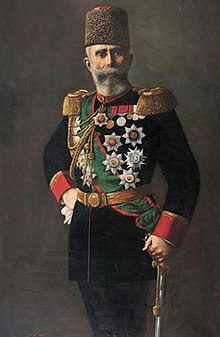Mahmud Shevket Pasha
Mahmud Shevket | |
|---|---|
 Mahmud Shevket Pasha by Simon Agopian (1857−1921) | |
| Grand Vizier of the Ottoman Empire | |
| In office 23 January 1913 – 11 June 1913 | |
| Monarch | Abdülhamid II |
| Preceded by | Kâmil Pasha |
| Succeeded by | Said Halim Pasha |
| Personal details | |
| Born | 1856 Baghdad, Baghdad Eyalet, Ottoman Empire |
| Died | 11 June 1913 Istanbul (then Constantinople), Ottoman Empire |
| Nationality | Ottoman |

Mahmud Shevket Pasha (Turkish: Mahmut Şevket Paşa; 1856 – 11 June 1913)[2] was an Ottoman general and statesman. He was born in Baghdad, where he finished his primary education before going on to the Military Academy (Turkish: Mekteb-i Harbiye) in Constantinople.[3] He joined the army in 1882 as a lieutenant. He spent some time in France investigating military technology and was stationed in Crete for a while. He then returned to the Military Academy as a faculty member.
He worked under Colmar Freiherr von der Goltz (Goltz Pasha) for a while and traveled to Germany. He was then appointed as governor of the Kosovo Vilayet, where he commanded the 3rd Army, which was later known as Hareket Ordusu ("Army of Action") after its involvement in suppressing the counterrevolutionary absolutist reactionaries in the 31 March Incident. A voice recording of Mahmud Shevket Pasha speaking to rally his troops against the counterrevolutionaries in 1909 was released in by journalist Murat Bardakçı in 2012.[4]
He played an important role in ending the 31 March Incident and with it, the reign of Abdul Hamid II. He served as a Grand Vizier to Mehmed V from 23 January. He was assassinated in Constantinople on 11 June 1913 in a revenge attack by a relative of the murdered Nazım Pasha.[2] Among other things, he is credited with the creation of the Ottoman Air Force in 1911 and bringing the first automobile to Constantinople. Mahmud Shevket Pasha gave much importance to a military aviation program and as a result the Ottoman Air Force became one of the pioneering aviation institutions in the world.[5]
Though raised as a Turk, various sources claim that he may have also had Iraqi Arab,[6] Georgian,[7] Chechen,[8] or Circassian[9] ancestry.

References
- ^ http://www.incirlik.af.mil/news/story.asp?storyID=123032165
- ^ a b David Kenneth Fieldhouse: Western imperialism in the Middle East 1914-1958. Oxford University Press, 2006 p.17
- ^ Finkel, Caroline, Osman's Dream, (Basic Books, 2005), 57; Istanbul was only adopted as the city's official name in 1930...
- ^ https://www.youtube.com/watch?v=xIRUC8p0t7M
- ^ http://www.hvkk.tsk.tr/EN/IcerikDetay.aspx?ID=19
- ^ Ali Bilgenoğlu, Osmanlı Devleti'nde Arap milliyetçi cemiyetler, Müdafaa-i Hukuk Yayınları, 2007, p. 87.]
- ^ "New York Times, May 17, 1909". The New York Times. 17 May 1909.
- ^ İsmail Hâmi Danişmend, Osmanlı Devlet Erkânı, Türkiye Yayınevi, İstanbul, 1971, p. 101. Template:Tr icon
- ^ Nâzım Tektaş, Sadrazamlar: Osmanlı'da ikinci adam saltanatı, Çatı Kitapları, 2002, p. .
- Use dmy dates from November 2010
- 1856 births
- 1913 deaths
- People from Baghdad
- Iraqi people of Georgian descent
- Iraqi people of Chechen descent
- Iraqi people of Circassian descent
- Ottoman Military Academy alumni
- Ottoman Military College alumni
- Pashas
- Field marshals of the Ottoman Empire
- 20th-century Ottoman Grand Viziers
- Ottoman people of the Balkan Wars
- Assassinated Ottoman people
- Turkish people of Chechen descent
- Chechen people
- Ottoman Empire people stubs

